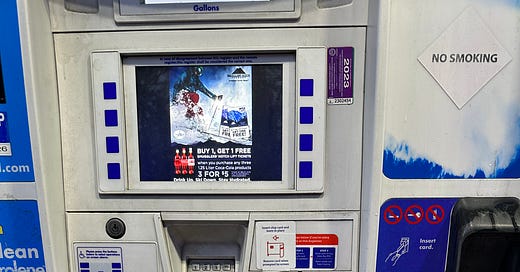A Little Distance Goes a Long Way... for Pricing Power
Hanover-Lebanon gas stations, Bertrand price competition, and the Hotelling model.
“Fuel reserve”, blared across the orange neon HUD of my sedan. That’s right, I thought, I traveled several hundred miles from NY to NH and didn’t stop to get fuel. That was over a week ago. As I drove into Hanover from Lebanon, a distance of—let’s see what Google Maps says—3.2 miles, I passed by two gas stations no more than—consulting Google, once again—1.4 miles apart. The distance between Irving Oil and Exxon is negligible enough that drivers stopping at either must know of the other. I believe this second assumption is eminently reasonable given the on-board gas-station-finding tech as well as the virtually ubiquitous access to Google Maps (of which I am clearly a fan and avid user). This premise provisionally accepted, I would expect the retail gas prices offered to be nearly the same.
This was decidedly not the case.
The standard-grade gas at Irving was $3.09 while Exxon’s was $3.39, a full thirty cents more. Given the perfect substitutability of the firms’ products—no room for vertical differentiation between perfectly homogeneous products such as gasoline—and relative proximity to each other, the Bertrand model would predict price competition down to marginal cost. TL;DR: the amateur economist—yours truly—was anticipating both stations would be selling gas for $3.09 a gallon. After all, why would anybody shop at Exxon when they could drive literally two minutes down the road and save about 10% per gallon? Perhaps the Hotelling model can help us understand the pricing power exhibited by Exxon.
If searching costs are higher for the average driver than I suspected, wealthy, older, less-technologically-savvy Hanover residents may be rationally ignorant of the Irving gas station a mile and some change out of town. In this case, Exxon successfully (horizontally) differented itself from Irving, as predicted by the Hotelling model, by locating closer to center of a more densely populated and wealthier town. The looser budget constraints of its customers and the premium they place on their time allows Exxon to price discriminate and charge significantly above Irving. Frankly, I would not have anticipated this outcome considering how close they are. That said, they are not as close as other gas stations located right across the street from each other or at least with price listing within viewing distance of each other—no wonder those signs are so large, lighted, and visible!
I will report back on this situation tomorrow to see if Exxon has been disciplined a la Bertrand and lowered prices to within a narrower range of Irving’s. Stay tuned!




